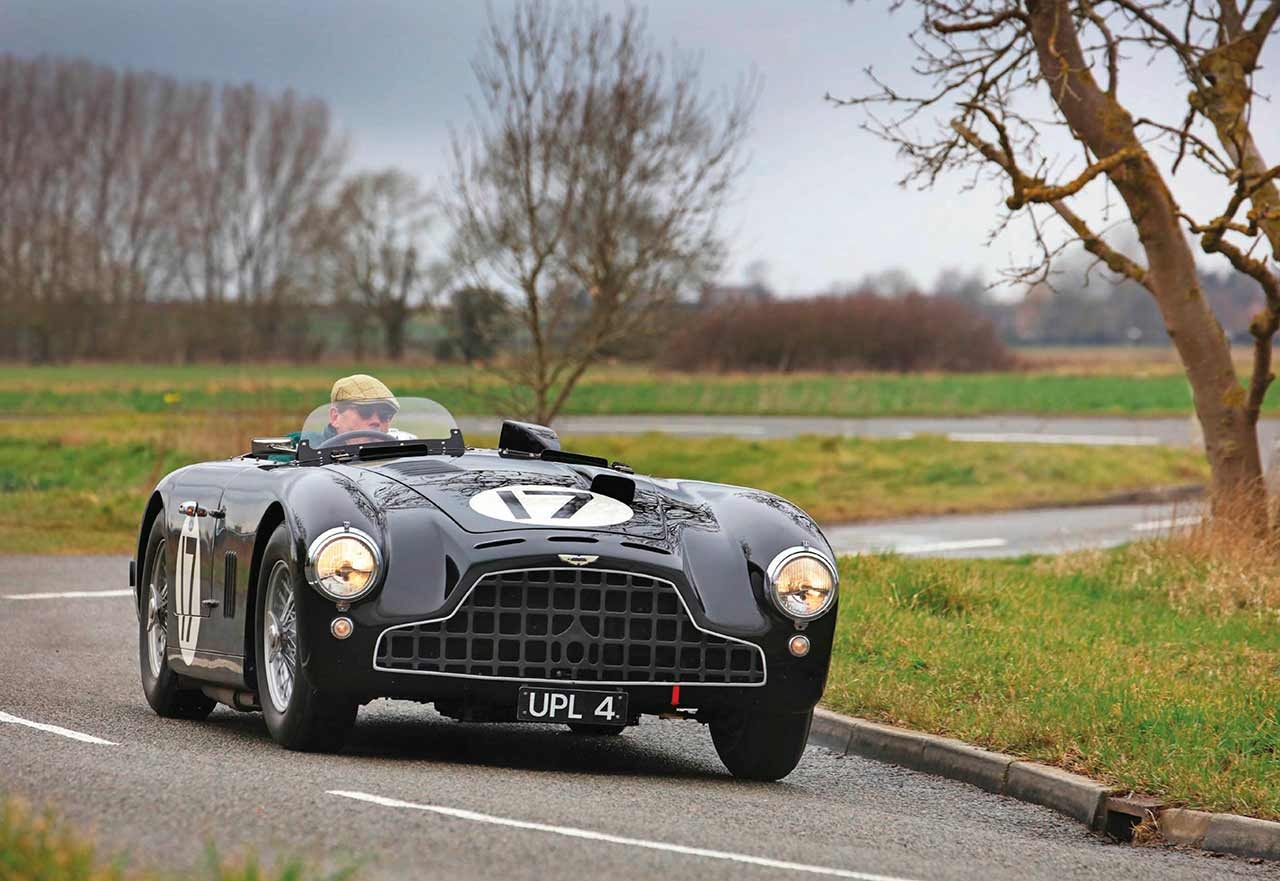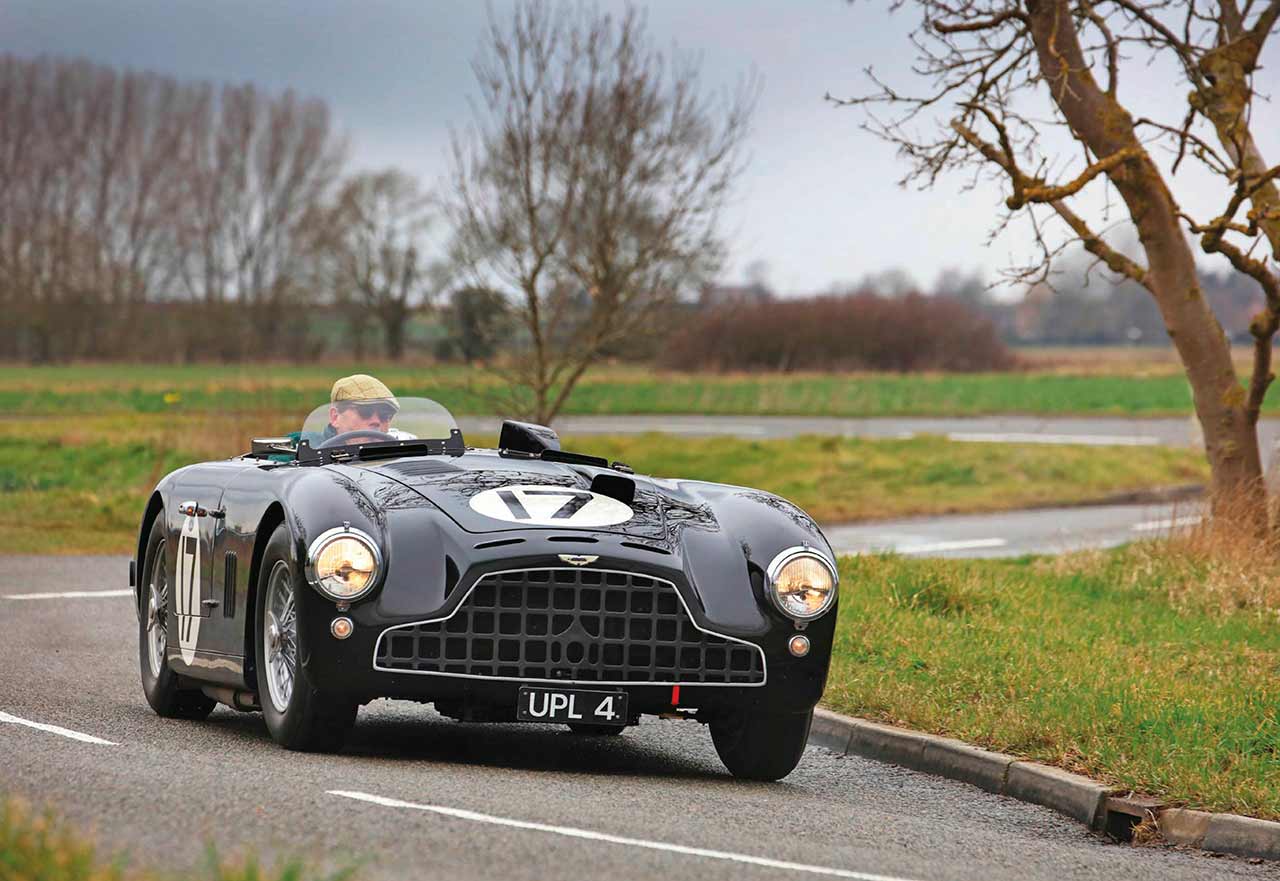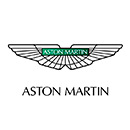
Aston Martin DB3 Mick Walsh takes to the open road in the first Goodwood Nine Hours winner Foundations for success. Hitting the open road in the Goodwood Nine Hourswinning DB3, Aston Martin’s first sports-prototype. Words Mick Walsh. Photography James Mann.
ASTON MARTIN DB3 RACER HITS THE ROAD
Walking across the concrete car park of Feltham’s Cineworld complex, it’s hard to conjure the Aston Martin history that was played out here during the austere post-war years. But back in December 1950, a Vienna-born engineer arrived to lead the engineering team developing Aston’s first true sports-racing prototype. What perfectionist Professor Eberan von Eberhorst made of the grey London borough isn’t difficult to imagine, but industrialist David Brown was convinced that the genius who helped mastermind the Auto Union GP titans was best suited to put Aston Martin on the international racing map.

The works DB2 coupé’s impressive results had encouraged Brown and team manager John ‘Death Ray’ Wyer to take on the better-financed racers from Jaguar, as well as the Stuttgart and Modena exotics. Development proved slow, missing a planned Le Mans entry, but 22 months after the Austrian’s arrival the new DB3 made its debut in the 1951 Tourist Trophy. With Lance Macklin at the wheel, the rather plain-looking car was quicker than the DB2 but no match for the C-types, with 114mph against 128mph over Dunrod’s flying kilometre. In the race, Macklin gave his best chasing leader Stirling Moss until a bearing failure forced retirement after 27 laps.
As the season closed, the Feltham team had more time to sort Eberhorst’s design. Following Auto Union practice, the ladder chassis had large-diameter tubes with an emphasis on rigidity rather than lightness. The suspension used transverse torsion bars with trailing links at the front and a de Dion rear located by trailing links and a Panhard rod. While Jaguar was secretly developing disc brakes, Aston stuck with large Alfin drums but inboard at the rear to reduce unsprung weight. Early cars had a problematic five-speed ’box, but this was soon replaced by a revised four-speed from the Lightweight DB2. The engine was also developed from the racing coupé’s power unit, the dohc straight-six ‘LB6’ sucking through triple Weber carburettors and with higher compression, giving 140bhp.
The aluminium body by Frank Feeley was in two main parts that sandwiched the chassis to ease its removal. Like much of the DB3’s design, however, it proved too heavy and during wet races it leaked everywhere, turning the car into a mobile bath – much to the drivers’ discomfort. The team always seemed short of time and money, particularly compared to its Coventry rival, and Eberhorst’s perfectionist approach frustrated Wyer and engineer Willie Watson, who preferred a ‘try it and see’ approach. The quest for much-needed power included developing a 3-litre engine, an aluminium cylinder head and even a supercharger, but all were aborted when the original 2.6 proved most reliable.
The first full season was plagued by development problems as the overstretched team took on too many event commitments, while a new driver signing – motorcycle ace Geoff Duke – caused added tension. Monaco and Le Mans proved disastrous, not helped by the misguided idea of driving cars to events. A win finally came in August ’1952 – for DB3/5, the very car featured here – in a new night race at Goodwood. Yet even this moment was clouded by near disaster.
Organised by the BARC and sponsored by the News of the World, the Nine Hours was created to attract more European teams, but in the end there were only two foreign entries. Nonetheless, the prospect of a battle between the Jaguar and Aston Martin teams, with handsome young English rivals Moss and Peter Collins pitched against each other, attracted a huge crowd. After a frustrating season for both works equipes there was much to prove. The Saturday event started at 3pm, running until midnight, and the Jaguar C-types immediately proved quickest around the short, fast airfield track. To compensate, Wyer decided to refuel the Aston Martins every 1½ hours, thus keeping a lighter load and keeping his drivers fresher with shorter stints.
Just prior to the race a heavy rainstorm drenched the circuit, and quickly the heavier, less powerful Astons came into their own. The Jaguars of Tony Rolt and Moss led for the early laps while a frustrated George Abecassis was last away, but the positions quickly changed; Reg Parnell’s Aston claimed the lead on lap 8 and all eyes were on a fired-up Abecassis, who stormed through the field to third. But as the track dried out so Jaguar regained control, leaving Parnell and Collins (in DB3/5) running third and fourth.
At a third distance, just as the race was settling down, a fire flared in the pits. As Eric Thompson pulled in to switch with Parnell, the refuel turned into a nightmare: petrol spilled from the full tank was ignited by the overheated back axle and inboard brakes, and the Aston became an inferno. With a Shell tanker parked close by, the situation could have been far worse, but the fire brigade prevented a catastrophe. Wyer and two mechanics were rushed to hospital while Parnell, without a car, switched to team manager.
Into the darkness the Jaguars set the pace, headed by Moss and Peter Walker, with the DB3 of Collins and Pat Griffith in fourth, splitting the two privateer Ferraris. At 9pm, Jaguar’s luck ran out. First Duncan Hamilton lost a wheel, then Moss retired with a broken axle. Now up to second, Collins could see no way of catching an on-form Roy Salvadori in the 2.7-litre V12 Ferrari, which howled around the circuit while the Aston started to sound ominously rough.
But the constant use of lights had drained the Ferrari’s battery, so when Salvadori switched off to refuel and change drivers, the V12 refused to restart. Three laps were lost as the team struggled to replace it, and Aston took the lead. The Feltham team’s dramas continued, the new leader’s engine losing power due to a broken exhaust valve, but Collins nursed the car to the finish and the crowd cheered the British team on to its first major victory. Collins and a frustrated Salvadori in third had impressed, and both would become key players in Aston’s future racing history.
Wyer and his mechanics remained in hospital for several weeks, but that didn’t stop the team manager reviewing the Goodwood events from his bed and planning more testing through the winter months. Two cars, including the winning DB3/5, were rebuilt and fitted with new 2.9-litre engines for Monza testing. Early in December, the Fordson van was loaded up – the team had learnt its lesson after driving cars to events earlier in the year – for the trip to Italy, while the drivers flew down in Brown’s De Havilland Dove. Despite various delays, the times were encouraging, with Collins in DB3/5 completing 38 laps at 100mph and breaking the sports car lap record in the process – in spite of a fractured exhaust manifold and slipping clutch. The test was eventually halted due to snow, but the team returned to Feltham in good spirits.
For the 1953 season, the FIA introduced a new Manufacturers’ World Championship comprising seven major events but, due to limited resources, Wyer decided to enter just four – starting with Sebring, which was considered key to marketing Aston Martin in the US.
Three cars, including DB3/5, were shipped on the SS America, with Collins the only driver travelling by boat and transporter while the rest of the team flew. Much to Aston’s disappointment, it was the only European team entered, but still faced strong opposition from a lone Cunningham C4R and privateer Ferraris. After various practice problems on the 5.2-mile air-feld circuit, including overheating and collisions with the concrete-filled marker barrels, the race began strongly for the green cars. Collins made a storming start, gaining an advantage by just flinging his seatbelt over his lap while others struggled to clip theirs. Parnell stalled DB3/5 and was last away, yet by lap three he’d passed more than 50 cars to take third. In the charge back, however, while avoiding a DB-Panhard he’d hit another marker, which pushed the wing on to the tyre and smashed the headlamp. The damage would later delay a wheel change and handicap the team’s pace in the dark.
Collins continued to lead until switching over to motorcycle champion Duke, who was trying to prove that his talents were equally strong on four wheels. Perhaps trying too hard in his first stint, Duke collided with two slower entrants, the subsequent damaged de Dion forcing retirement – much to Collins’ fury. Parnell and Abecassis charged on after the Cunningham, but as the sun set the broken headlight proved a real challenge. After a gruelling 12 hours, with its brake linings destroyed by the Sebring circuit, DB3/5 finished runner-up to take a class win and Aston’s first world championship points.
Back from America, the team focused on the Mille Miglia, with three cars entered including DB3/5 for Abecassis with Pat Griffith. The tough Italian road race lacked Mercedes-Benz in 1953, but a formidable entry of works Ferraris, Lancias, and Alfa Romeos faced the lone English team. Despite mechanical problems, Parnell produced a remarkable result in a very unfit machine. With photographer Louis Klemantaski as his passenger, he pushed on with first a dislocated de Dion tube, then a broken throttle cable. Amazingly, Parnell fixed the throttle open and drove to the finish on the ignition switch.
Fifth overall would be the highest ever achieved on the Mille Miglia by a British marque. On the Siena-Florence section, Parnell was beaten only by Juan Manuel Fangio and Gianni Marzotto. Collins struggled with overheating, steering problems and a fractured de Dion, but limped to 16th. A failed steering box mounting also ended DB3/5’s race, resulting in Abecassis smashing into a bar in Galluzzo and injuring a spectator.
The DB3 as a works entry competed in one last event, the Silverstone International Meeting, with three cars hurriedly prepared after the dramas in Italy. Abecassis was entered in DB3/5, but the car was too badly damaged to be repaired in time. Although outperformed by the 4.1-litre Ferraris of Mike Hawthorn and Tom Cole, the Astons still beat Jaguar, with Parnell and Collins in third and fourth. Duke, never happy in the Aston team, retired with a failed clutch, and subsequently returned to motorbikes.
A new car, the beautiful DB3S part developed by Willie Watson with Eberhorst, was by now ready for testing at Monza, and the five older team cars were sold to privateers. As with many of the DB3s, the body of this car was modified into an odd-looking coupé inspired by the more flowing DB3S. New owner Nigel Mann, teamed up with Charles Brackenbury, continued to race DB3/5 at French events including the Hyères 12 Hours and GP de Baule, the roof soon replaced by a single-cowl screen and D-type-style headrest.
Registered UPL 4 and carrying a Union Jack on the nose, DB3/5 eventually went to Hong Kong in 1958, but in the late ’50s ended up with Preston Hopkins in America. The Aston then disappeared for two decades until discovered by historic racer Tony Goodchild, who rebuilt and developed DB3/5 while retaining the DB3S-style body. Fitted with a hot twin-plug head, the car proved quick at US events, with Goodchild competing at Road Atlanta, Pittsburgh and Road America, as well as local track Lime Rock. He even shipped DB3/5 to the UK in 1985 to race at Silverstone.
British collector Hugh Taylor eventually returned the car to England in 1990, where he commissioned a full restoration including an authentic Feeley-style DB3 body. With a wealth of historic photographs sourced by Brian Joscelyne, Crailville Coachworks did a superb job of remaking the two-piece bodywork while Peter Watts rebuilt the chassis and engine. Later owners have included Aston connoisseur Simon Draper, and most recently Martin Melling.
Originally a C-type was on Melling’s dream list but, guided by experienced historic racing specialist Rick Hall and son Rob, he switched to an Aston. “When the DB3 became available it seemed a rarer and more interesting option,” says Rob. “With the car’s history it was eligible for all the top events, and with just 10 built it was more likely to guarantee an entry. The downside was all the period performance limitations, particularly the weight and small brakes.”
Hall & Hall was convinced that the DB3’s performance could be transformed without modifications that would spoil its originality. A new engine was built around an original spare block from Four Ashes Garage, with a lighter crank and pistons. “It now revs a lot easier with plenty of low-down torque, which makes it very tractable,” says Rob, who has raced it extensively including winning back at Goodwood in last year’s Freddie March Memorial Trophy. “It’s a nice old girl with very neutral handling. With our stiffer front and softer rear set-up, the turn in is good through fast corners and you can control it nicely on the throttle. The steering is heavy, but I prefer it that way because it gives more feel. The car seems to suit Goodwood.”
Having watched both Halls race DB3/5, I was very excited about a test drive around the open Fenland roads near their impressive workshops. Although the car’s styling lacks the sexy curves of its successor, the solid-looking DB3 takes you back to the early ’50s. With its portcullis-style grille and square sides, it looks like a full-size Dinky toy casting, but new Borannis with exotic three-eared spinners enhance its functional aura.
Carrying number 17, honouring its Goodwood win, and early ‘ram air’-style bonnet duct, the car only lacks the signature centre spotlight. Pulling open the long door and slipping down into the low leather bucket seat, you can’t help but reflect on the car’s colourful history, be it Collins conserving the ill-sounding engine around a pitch-dark Goodwood, or Abecassis at Sebring cursing slower cars as he chased into a Florida sunset with a broken headlight.
You sit low in the cockpit, legs outstretched on the aluminium floor to the well-spaced pedals with a handy footrest on the transmission tunnel. The dash layout is strange, with no dials directly behind the three spoke, leather-trimmed steering wheel; the black-faced instruments are all offset, taking your eye away from the road ahead. Although the gauges are new, the ignition switch with Bakelite knob is original and probably thumbed by heroes Collins and Abecassis.
Turn the key, flick on the fuel-pump switch, thumb the starter and the straight-six wakes with a rich, deep rasp. Driving out of Bourne on wet roads, the gearbox feels stiff, the clutch fierce and the steering weighty, but once everything is warmed up and speed increases, the controls reassure. The all-synchromesh gearchange via a short, stubby lever in a close gate is slick, but I can’t resist double declutching just to hear that crisp exhaust. Out on deserted, flat roads the power delivery is smooth, the torque encouraging ever faster corner exits. With its firm set-up the car feels flat and neutral through the bends. Even the brakes inspire once warmed, but it’s no doubt a different story after relentless laps being chased by hot-rod Cooper-Jaguars.
As in most competition Astons, you feel relaxed in a cockpit whose layout is well thought out for endurance races. Even with just an aeroscreen for protection, my flat cap stays on at speed and I’d love to experience the car at night, but wet weather forces us to turn the immaculately prepared machine back to Bourne. Hours later I can still hear that raucous straight-six.
Owner Melling has taken chassis 5 to all the major historic events where DB3s originally raced, but with none of the dramas that cursed the team in period. Be it Hall retracing Collins’ winning way at Goodwood, or Melling driving through the morning mist across Tuscany, there’s nothing like taking a great car back to where it made history to celebrate the characters that designed, developed and raced them.
Thanks to Rick and Rob Hall: www.hallandhall.net
Photos
Clockwise: Peter Collins accelerates into the twilight en route to victory with DB3/5 at the first Goodwood Nine Hours; the same chassis roars across Fenland roads today; dohc ‘six’ with triple Webers. Well set up for enduros, the DB3 cockpit features central cluster and stubby gearlever – note chassis tubes that follow GP Auto Union practice. Below: bucket seat and Goodwood scrutineering stickers. ‘The all-synchromesh ’box is slick, but I can’t resist double-declutching just to hear that crisp exhaust’ Clockwise, from left: Feeley designed DB3 body in two parts for easy access to chassis, but it leaked badly; Goodwood refuelling drama hospitalised boss Wyer; team arrives in Brescia for the 1953 Mille Miglia.






